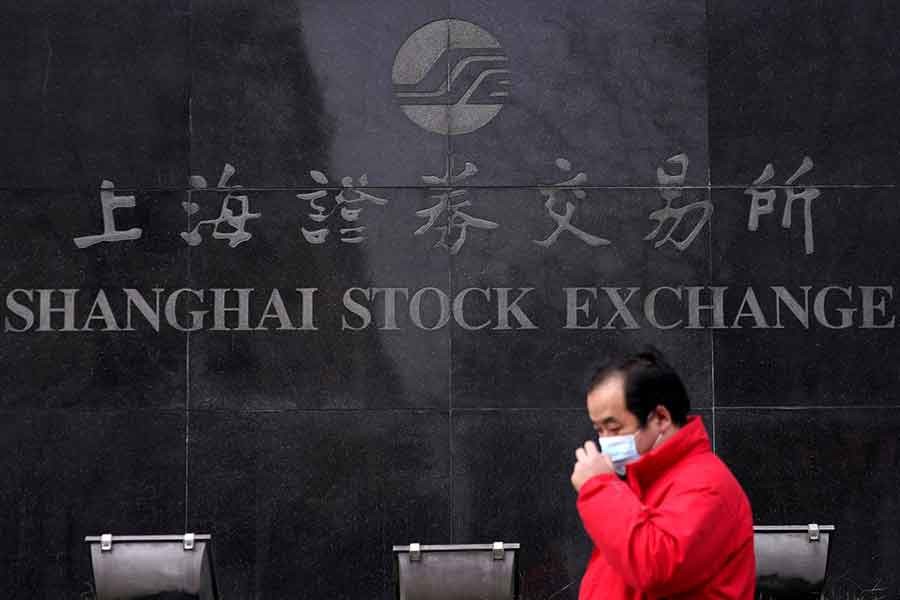Asian shares swung higher on Monday as Wall Street futures stabilised, though tests loom ahead as UK interest rates are expected to rise this week and surging oil prices add to worries over inflation.
Data out on Sunday showed China's factory activity slowed in January as a resurgence of COVID-19 cases and tough lockdowns hit production and demand.
The standoff over Ukraine remains a thorn in the market's side, with concerns a Russian invasion would also cut vital gas supplies to western Europe.
Lunar New Year holidays made for thin conditions and MSCI's broadest index of Asia-Pacific shares outside Japan (.MIAPJ0000PUS) nudged up 0.6per cent in slow trade.
Japan's Nikkei (.N225) bounced 1.3per cent from a 14-month trough, though local data on industrial output and retail sales undershot forecasts.
S&P 500 futures and Nasdaq futures recouped early losses to rise 0.3per cent, while EUROSTOXX 50 futures rallied 1.2per cent and FTSE futures 0.6per cent.
The Bank of England is likely to hike rates again this week, continuing the global trend toward tighter policy. The European Central Bank also meets but is expected to stick to its argument that inflation will recede over time. read more
Markets have swung to pricing in five hikes from the Federal Reserve this year to 1.25per cent , though investors still see rates peaking at a historically low 1.75-2.0per cent.
Analysts at BofA think that is not nearly hawkish enough.
"We point out that markets have underpriced Fed hikes at the start of the last two hiking cycles and we think that will be the case again," says BofA chief economist Ethan Harris.
"Starting in March, we expect the Fed to start raising rates by 25bp at every remaining meeting this year for a total of seven hikes, with four more hikes next year," he adds. "This would take the terminal rate to 2.75-3.00per cent by the end of 2023, which should slow down growth and inflation."
The Fed diary is rather sparse this week with only three regional presidents scheduled to speak, but there is plenty of data highlighted by the ISM readings on manufacturing and services, and the January jobs report.
The headline payrolls number is expected to be soft given a surge in coronavirus cases and adverse weather. The median forecast if for a rise of just 155,000, while forecasts range from a gain of 385,000 to a drop of 250,000, Reuters reports.
"We expect nonfarm payrolls to rise by only 50,000 in January and for the unemployment rate to hold steady at 3.9per cent," said analysts at Barclays in a note.
"We see downside risk to our forecast given the 8.8 million adults that were not working during the week of Jan. 11 in order to care for someone sick, or they themselves were sick."
The hawkish turn by the Fed has seen US 10-year Treasury yields spike 27 basis points this month to 1.78per cent, making bonds relatively more attractive compared to equities and particularly growth stocks with stretched valuations.
It has also bolstered the US dollar, which has jumped 1.7per cent so far this month against a basket of its main rivals to the highest since July 2020 and was now at 97.167.
The euro shed 1.7per cent last week,, dropping to its weakest since June 2020, and was last trading at $1.1157 . The dollar even gained on the safe haven yen, rising 1.3per cent last week, to stand at 115.53 yen.
Higher yields have been a deadweight for gold, which pays no return, and the metal was down at $1,787 an ounce , having shed 2.4per cent last week.
Oil prices were near seven-year peaks having climbed for six weeks straight as geopolitical tensions exacerbated concerns over tight energy supply.
Brent rose another $1.18 to $91.21 a barrel, while US crude added $1.15 to $87.97.


